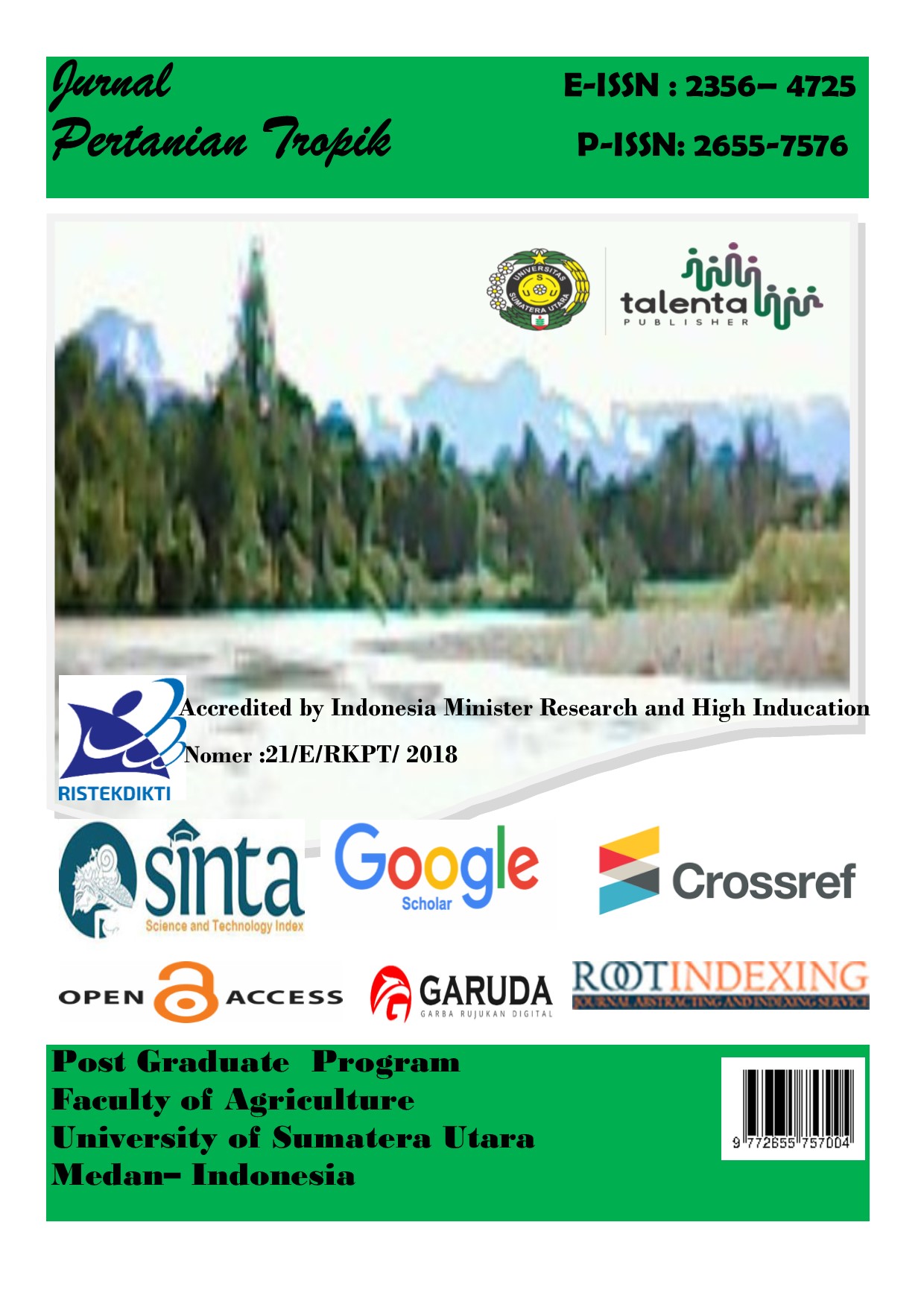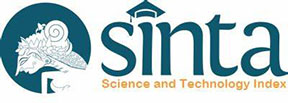Testing of Packaging and Use of Attractants to Control Fruit Flies(Bactrocera dorsalis Hendel) Guava (Psidium guajava L.)
DOI:
https://doi.org/10.32734/jopt.v7i3.4807Keywords:
Guava, Wrapping, Attractants, Fruit fliesAbstract
The aims of this study to determine: The effect of kinds attractants and time of wrapping on to control of percentage of fruit fly attacks which determined the guava quality. This research was conducted in Durin Jangak Village, Pancur Batu District, Deli Serdang Regency from May to July 2019. This research was conducted using a randomized block design method with three factors: time, wrapping, attractant. The result of this research showed that the treatment by using the white plastic wrapping and attractant traps obtained the highest fruit diameter is 10.23 cm and the lowest treatment with no packaging and without attractant traps is 7.40 cm. In the treatment by using the white plastic wrapping and attractant traps obtained the highest fruit weight is 586 grams and the lowest treatment using without wrapping and attractant traps is 165 grams. At the observation of the highest trapped fruit flies in the treatment without wrapping and attractant traps that were 961 fruit flies and the lowest trapped fruit flies were white plastic wrapping treatments and attractant traps that were 790 fruit flies. In the treatment without wrapping and attractant traps,wrapping gauze and attractant traps obtained the highest percentage of fruit attack, namely 100% and treatment of white plastic wrapping and attractant traps obtained the lowest fruit attack, consist of 33%.
Downloads
References
Affandi, I. 2004. Evaluation of Horticultural Characteristics of Six Melon (Cucumis melo L.) Hybrids (Ser II) Results of Crosses from the Center for Fruit Studies Tropical Fruits (PKBT) IPB. Essay.
Azmal AZ, and Fitriani. 2006. Surveillance on the Distribution of Fruit Fly Species in Belitung and East Belitung Districts, Tanjung Pandan Plant Quarantine Station, Available athttp://www.ditlin.hortikultura.go.id/lalat-nuah/lalat buah.htm-123k, Accessed on Oct, 18. 2020
Broto W. 2009. Postharvest fruit handling technology for the market. Bogor (ID): Center for Agricultural Postharvest Research and Development.
Central Java Agricultural Technology Research Center [BPTP]. 2008. Prima Tani in Banjarnegara Regency.http: //www.litbang.deptan.go.id.htm [Accessed July 14, 2011].
Central Bureau of Statistics. (2017, June 06) [BPS]. Central Bureau of Statistics Dynamic Table. Taken back from the Central Bureau of Statistics:https://www.bps.go.id/site/resultTab
Damayanti, M. 2000. The Effect of Type of Packaging and Wrapping Time on Quality of Water Guava Fruit. Department of Agricultural Cultivation. Faculty of Agriculture. Bogor Agricultural Institute. Bogor.
Department of Agricultural Cultivation. Faculty of Agriculture, Bogor Agricultural University.7 December 2011.
Ministry of Agriculture, 2005. Fruit Fly (Bactrocera dorsalis). Dalam: http:// ditlin.hortikultura.go.id/opt/jeruk/lalatbuah/lalat.htm, Retrieved June 6, 2014.
Ministry of Agriculture, 2007. Report on the Implementation of Working Group Coordination (POKJA) on Fruit Fly Pest Management, Bali.
Ditlintan. 2008. Guidelines for Food Crop Protection Observation and Reporting. Director of Plant Protection. Directorate General of Food Crops. Jakarta.
Habazar, T. and Yaherwandi. 2006. Biological Control of Plant Pests and Diseases. Andalas University Press. Padang.
Indriyanti DR. 2011. Exploration and potential of processed waste compounds as attractants for fruit flies Bactrocera carambolae (Diptera: Tephritidae). Dissertation report. UGM Yogyakarta.
Jain, N., K. Dhawan, S. Maholtra, R. Singh. 2003. Biochemistry of fruit ripening of guava (Psidium guajava L.): compositional and enzymatic changes. Plant Foods for Human Nutr. 58: 309-315.
Kardinan A. 2003. Fruit Fly Control Plants. Jakarta: Agro Media Pustaka.
Kardinan, Agus. 2008. Prospects of Aromatic Plants in Overcoming Mosquito and Flies Problems. Journal of Industrial Crops Research and Development, Volume 14 Number 1, Pages 25-23.
Misan. 2011. The effect of the type of packaging and the time of packaging on the quality of water guava fruit (Syzgium samarangense). Essay. Undergraduate Program, Bogor Agricultural University.
Nasir, N. Jumjunidang and Harlion. 1991. The effect of wrapping on the appearance of banana peels of Buai / Ambon, Barangan and Raja lemongrass varieties. Journal of horticulture. 4 (3): 42- 48.
Moon, DG, SW Ko, SG Han, CH Kim, CK Lim, JH Joa. 2015. Effect of bagging on 'Shiranuhi' mandarin fruit quality during growth and storage. Intl. J. Eng. and Appl. Sci. 2 (7): 2394-3661.
Rouse, P., PF. Duyck, S. Quilici and P. Ryckewaert. 2005. Adjustment of Field Cage Methodology for Testing Food Attractions for Friut Flies (Diptera: Tephritidae). Ann. Entomol. Soc. Am. 98 (3): 402-408.
Ryugo, K 1988. Fruit Culture It's Science and Art. John Wilwy and Sons Inc. USA.
Sari, AYN 2009. Effect of Number of Fruits and Toping (Toping) on Fruit Quality in Cultivating Melon (Cucumis melo L.) Using Hydroponic System. IPB.http: // repository.ipb.ac.id /bitstream / handle / 123456789/11454 / A09ayn.pdf? sequence = 2 downloaded 22 March 2015.
Siwi. 2014. Important types of fruit flies in Indonesia and their host plants. Center for Research and Development of Agricultural Biotechnology and Genetic Resources. Bogor
Trisawa, IM and EA Wikardi. 1997a. Response of Fruit Flies (Bactrocera dorsalis Hendel.) To Melaleuca bracteata Oil. Proceedings of the National Seminar on Entomology Challenges in the XXI Century, Bogor branch of PEI: 255-267
Wong, TTY, DO Mc Innis and N. Mochizuki. 1985. Seasonal Distribution and Abundance of Adult Male Oriental Fruit Flies (Diptera: Tephritidae) in Kula, Maui Hawaii. J. Econ. Entomol 78: 1267 - 1271.
Zhang, B., RJ Ma, ZX Cia, CH Zhang. ZM Yan. 2015. Effect of preharvestmicro environment inside bags on peach fruit quality. Plant Physiol.12: 38-42
Downloads
Published
How to Cite
Issue
Section
License
Copyright (c) 2020 Jurnal Pertanian Tropik

This work is licensed under a Creative Commons Attribution-ShareAlike 4.0 International License.






















